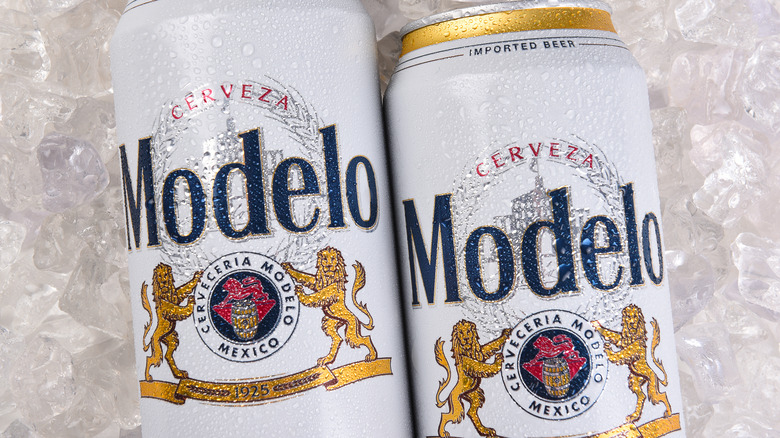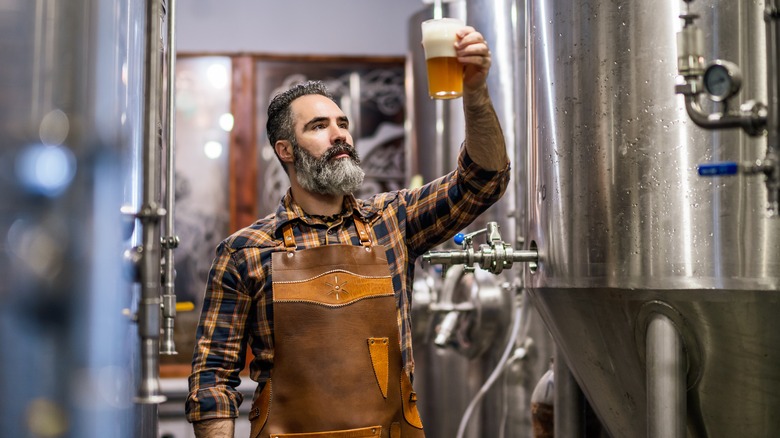Domestic Vs Imported Vs Craft: Here's What Makes Each Type Of Beer Different
When faced with the options of domestic, imported, or craft beer, the answer for many people is often little more than a puzzled look and a shrug. However, there are also those all too eager to answer that question, because just like the beer itself, beer drinkers can fall into their own categories.
Among those groups are those who drink beer because beer is beer, those who prefer the taste of some beer over others, and those who know and appreciate it as an art form and dedicate their lives to drinking it, brewing it, or mastering all beer-related education.
However, you're absolutely not alone if you don't fit into that last category. So, what's the difference between domestic, imported, and craft beer? Simply put, how and where it's made plays the most significant role in categorizing each type of beer.
Domestic beer
If you aren't a beer connoisseur or don't consider yourself one, then you may be wondering if you've ever ordered a domestic beer. Chances are high that you have. Or if you haven't, you've probably had one at a party, barbecue, game, or really anywhere America's most popular beers have been supplied en masse.
What domestic beer really means is that it was brewed in the same country a person lives in (for people in the U.S., this means American beer). These beers are mass-produced and maintain a highly consistent flavor profile with generally less expensive ingredients. Since lagers are the most popular type of beer, and domestics are brewed to sell, they're usually lagers. The recommended timeframe to drink them is within three months due to their lower alcohol content.
Each country has its own version of domestic beer. In the United States, Budweiser, Rolling Rock, and Pabst Blue Ribbon are just a few brands that have maintained a long hold on the domestic beer market. Domestics have fallen into a guilty-pleasure category for a lot of beer fans. The mass production and cheap ingredients leave some turning their noses up at a can or bottle. However, the consistency of domestics makes them a safe bet for those just looking to enjoy a drink without being too adventurous. When in doubt, stick to old faithful.
Imported beer
A lot of imported beers are so popular in the United States that it can be easy to forget that it's imported to begin with. Any beer that is brewed in a country that isn't the United States and is then imported to the U.S. is considered imported beer. This means that there are no clear characteristics of imported beer. This can include domestic beer from another country, craft beer, high quality, mass-produced — really anything as long as it's brewed outside the country you live in.
Some well-known imported beers include Modelo, which is brewed in Mexico, and Stella Artois, which is brewed in Belgium. Even though there are no specific characteristics of imported beer, in recent years, imported beers have recently been outperforming domestic beers in dollar amount sold. Mexican imported beers have seen soaring popularity and Modelo even claimed a spot as America's number one performing beer in 2023, beating out the legendary Budweiser. Since imported beers can be from any category, whether or not they're better tasting or higher quality than domestic beers depends on the brand and the drinker.
Craft beer
Craft beer is what transforms beer into an art form. It's a process conducted with care and precision from beginning to end. Craft beer is almost always brewed using higher-quality ingredients — the hops, malts, grains, and yeast are generally better than those used for domestic beer.
Craft breweries are popular in cities across the United States and are often proud of using local ingredients to create their beers. Being made in smaller breweries and utilizing local or unique ingredients means craft beer packs a richer flavor from start to finish. This also means craft beer can be more expensive than domestic beer. Many craft beers may come with a higher calorie count than their domestic beer cousins. According to a quote published in Health Enews from the Clinical Nutrition Coordinator at the Dublin Breast Center of the Tisch Cancer Institute of Mont Sinai Hospital, Kelly Hogan, "ABV is the most important factor to look for because beers with higher ABVs are typically higher in calories." So, if you're looking to count calories but still want to enjoy a full-bodied craft beer, make sure you look at the alcohol volume.



